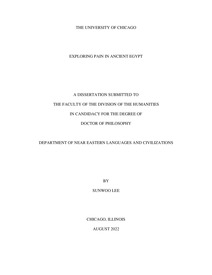This dissertation explores the meanings of pain in ancient Egypt by attending to various ways in which ancient Egyptian texts frame, articulate, problematize, and explain pain. This dissertation takes as its starting point the view that pain is a deeply cultural and historical phenomenon, and that a particular culture’s ideas and practices surrounding pain are intimately connected to that culture’s understanding of the human person (what man is, what man ought to be, what man’s place is in the world, etc.). As the most salient concepts or categories that are used to theorize about the human person in ancient Egypt are maat and the human heart, this study seeks to articulate Egyptian understanding of pain in these terms as well. More specifically, this study argues that the Egyptian notion of pain–which is far more expansive than English “pain” and encompasses the notions of illness, anguish, suffering and evil–can be best conceived of as a rupture in maat, and submits that for the Egyptians, it is the human heart that serves as the locus of the immanent reality of pain.The central argument is fleshed out by the means of a careful reading of the ancient Egyptian texts. After compiling the list of relevant vocabulary, I looked into the magico-medical texts, literary narrative texts and non-narrative literary texts. While sharing in broad orientation, these texts frame pain differently. Pain in magico-medical texts is understood as an object of empirical observation and performative action. In the literary narratives, pain serves to foreground the interpersonal relationships and elicits audience empathy. In the non-narrative literary texts, pain is an essential component of longing. In addition to providing a culturally nuanced account of Egyptian understanding of pain, my dissertation contributes to a new paradigm for approaching ancient texts that foregrounds the role of affect and empathy.
Thursday, January 12, 2023
Exploring Pain in Ancient Egypt
Subscribe to:
Post Comments (Atom)










 Stumble It!
Stumble It!

No comments:
Post a Comment